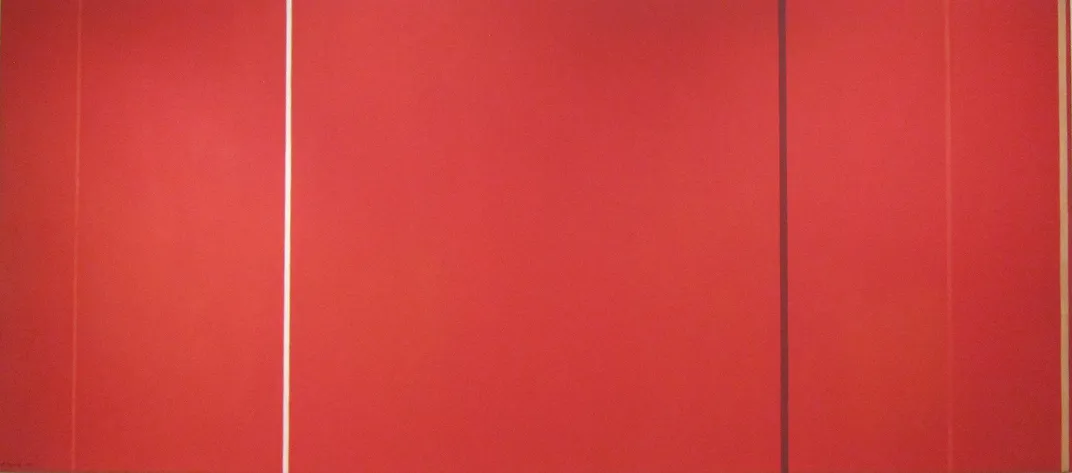Study Finds Paintings Featuring Blue and Red Hues Sell for the Most Money at Auction
There’s green to be found in shades of red and blue
/https://tf-cmsv2-smithsonianmag-media.s3.amazonaws.com/filer/63/19/6319d203-1725-4c91-b967-e35dd1307ef7/download.jpeg)
To those outside of the art world, the astronomical amount of money collectors spend at auction can be hard to comprehend. Why would someone pay $12 million for Damien Hirst’s “The Physical Impossibility of Death in the Mind of Someone Living”—an actual stuffed shark suspended in a glass case filled with formaldehyde—or shell out nearly half a million dollars for a portrait of a fictional French aristocrat just because it was made with AI programming?
The ever-shifting forces behind art market sale prices are notoriously difficult to pinpoint. Still, as Philip Hook, Sotheby’s senior director of Impressionist & Modern Art, argued in a 2013 op-ed for the Guardian, some factors remain relatively consistent across the board. Of the characteristics he isolated, perhaps the most important and elusive selling point was the “visceral impact” of a work, defined by a host of intangibles including emotional power, composition and color. Simply put, Hook observed at the time, “Blue and red tend to be good news.”
Hook is far from the first to suggest there’s green to be found in shades of red and blue. Still, a new study led by economists from the Netherlands’ Tilburg University is the first to put the theory to the test. And as Jasmine Weber reports for Hyperallergic, the research—directly inspired by the 2013 column—appears to support the popular adage: On average, the team found that primarily blue-hued paintings attract 18.57 percent higher bids and stronger intent to purchase than those dominated by alternative colors. Red paintings revealed similar gains, with bids increasing by an average of 17.28 percent.
According to artnet News’ Tim Schneider, researchers Marshall Ma, Charles N. Noussair and Luc Renneboog of the CentERlab at Tilburg relied on data from the Blouin Art Sales Index to track 5,500 abstract works sold at auction between 1994 and 2017. In order to focus on paintings’ hue, the trio excluded works with competing aesthetic properties such as figuration, geometric patterns and non-rectangular canvas shapes. The final pool, the team writes in the study, consisted mainly of “single-color non-figurative abstract paintings” in the style of Abstract Expressionism. (Think of Mark Rothko and Barnett Newman’s Color Field canvases.)

For every standard-deviation increase in blue pigment beyond what the authors describe as a “benchmark white,” sale prices rose by 10.6 percent. For red-heavy works, this figure was closer to 4.2 percent.
Translated into dollar values, the extra edge afforded by blue and red hues was substantial. Schneider notes that for every standard-deviation increase in blue, prices jumped by around $53,600. Comparatively, red paintings enjoyed a nearly $21,200 price boost for every standard-deviation increase in color.
In addition to analyzing previous auction records, the economists recruited around 500 students for an experiment that measured emotions associated with specific colors in paintings. Asked to view selected works on a digital monitor, participants rated their emotional responses, ranked paintings in terms of preference and, finally, took part in a simulated auction.
The researchers write that they chose volunteers from three universities located in China, the United States and the Netherlands in an attempt to offset any color bias attributed to one specific country of origin. Across the board, participants appeared to follow the same trend exhibited by real-life auctions, bidding almost 20 percent more than average for heavily blue and red paintings.
The exact reasons for these colors’ elemental attraction remain unclear, but as the authors explain, red is often associated with feelings of adventure, aggression, power, arousal, bravery and excitement. Blue, on the other hand, connotes dignity, poise, reserve, relaxation, intellect and comfort.
Ma, Noussair and Renneboog’s findings may add a semblance of scientific rigor to an often unpredictable market. Who knows? Perhaps Leonardo da Vinci’s “Salvator Mundi,” the most expensive painting ever sold at auction, owes a sliver of its $450 million price tag to the lush blue tones of its central figure’s robes. After all, stranger things—we’re thinking of the Louvre Abu Dhabi’s indefinite postponement of “Salvator Mundi”’s debut, as well as rumors that it’s all but missing—have happened.
/https://tf-cmsv2-smithsonianmag-media.s3.amazonaws.com/accounts/headshot/mellon.png)
/https://tf-cmsv2-smithsonianmag-media.s3.amazonaws.com/accounts/headshot/mellon.png)